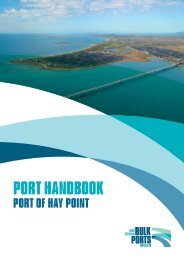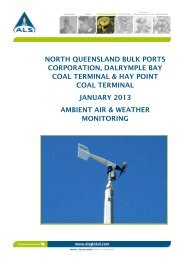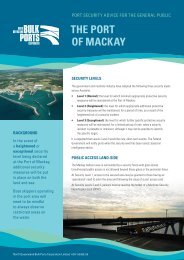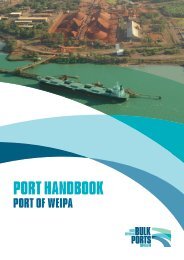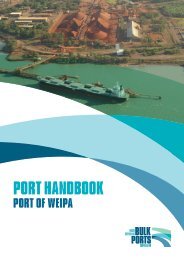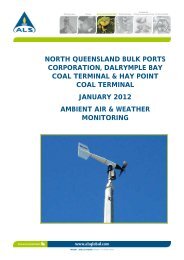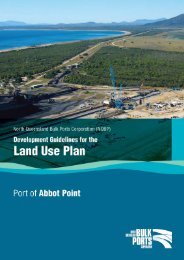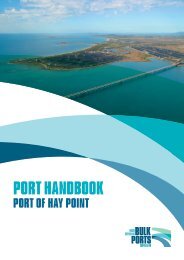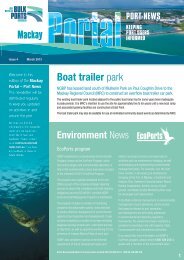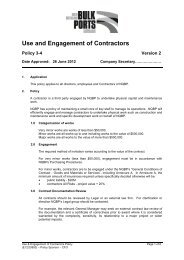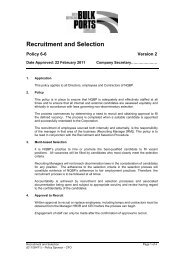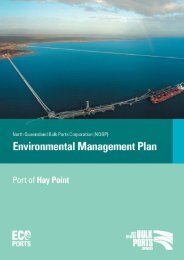Terms of Reference - North Queensland Bulk Ports Corporation
Terms of Reference - North Queensland Bulk Ports Corporation
Terms of Reference - North Queensland Bulk Ports Corporation
- No tags were found...
Create successful ePaper yourself
Turn your PDF publications into a flip-book with our unique Google optimized e-Paper software.
managed, should be derived from the Acid Sulfate Soils Laboratory MethodsGuidelines (Ahern et al. 2004) and the Soil Management Guidelines (Dear et al. 2002).Assessment <strong>of</strong> marine sediments should be undertaken in accordance with the NAGD.Detail specific measures to maintain sediment quality to nominated quantitativestandards within the project and surrounding areas, particularly where futuremaintenance dredging may be required.Note: Dredging with disposal <strong>of</strong> spoil on land (above the MHWST) requires anallocation <strong>of</strong> quarry material, under the provisions <strong>of</strong> the Coastal Act, prior toapplication for tidal works approval under SPA.Potential impacts and mitigation measuresDescribe the potential environmental impacts caused by the project on coastal waterand sediment quality, and associated management and mitigation measures, including:• potential impacts associated with constructing and operating the coastal and marinefacilities• in the context <strong>of</strong> the DMP, potential impacts due to dredging and dredge materialdisposal, including disturbance <strong>of</strong> fine-grained sediments (for examples, metals,nutrients, PASS or contaminant release), reduced light attenuation and additionalsedimentation on coral reefs and seagrasses• potential accidental discharges <strong>of</strong> contaminants during construction and operation <strong>of</strong>the coastal and marine facilities• release <strong>of</strong> contaminants from marine structures and vessels, including potential forintroducing marine pests• stormwater run-<strong>of</strong>f from the coastal facilities and associated infrastructure• flooding <strong>of</strong> local watercourses and other extreme weather events.Provide management strategies for dredging, loading and spoil disposal, including anyrequired trigger levels for management actions linked to quantitative measurements <strong>of</strong>water quality.For any onshore dredge spoil disposal options, provide a detailed assessment, withappropriate staging plans. The assessment should demonstrate the quality <strong>of</strong> the waterdischarged from dredge spoil disposal areas will meet standards necessary to achievewater quality objectives and therefore maintain receiving water environmental valuesthroughout the period <strong>of</strong> dredge spoil disposal on land. Consideration should be givento:• quantities <strong>of</strong> tailwater likely to be generated from dredging activities• the settling rate <strong>of</strong> fine sediments from all dredge material types• the residence time within settling ponds prior to discharge (related to dredgepumping rate, ratio <strong>of</strong> solids to water in spoil, settling rates, available capacity <strong>of</strong> thedisposal and settling areas, potential bulking factor, intensity and duration <strong>of</strong> rainfallevents with consideration given to the worst case scenario for these factors)• source <strong>of</strong> material for bunds and bund wall stability• measures to limit channelling and sediment re-suspension in settling ponds- 34 - Contents <strong>of</strong> the EISDudgeon Point Coal Terminals Project<strong>Terms</strong> <strong>of</strong> reference for an environmental impact statement



